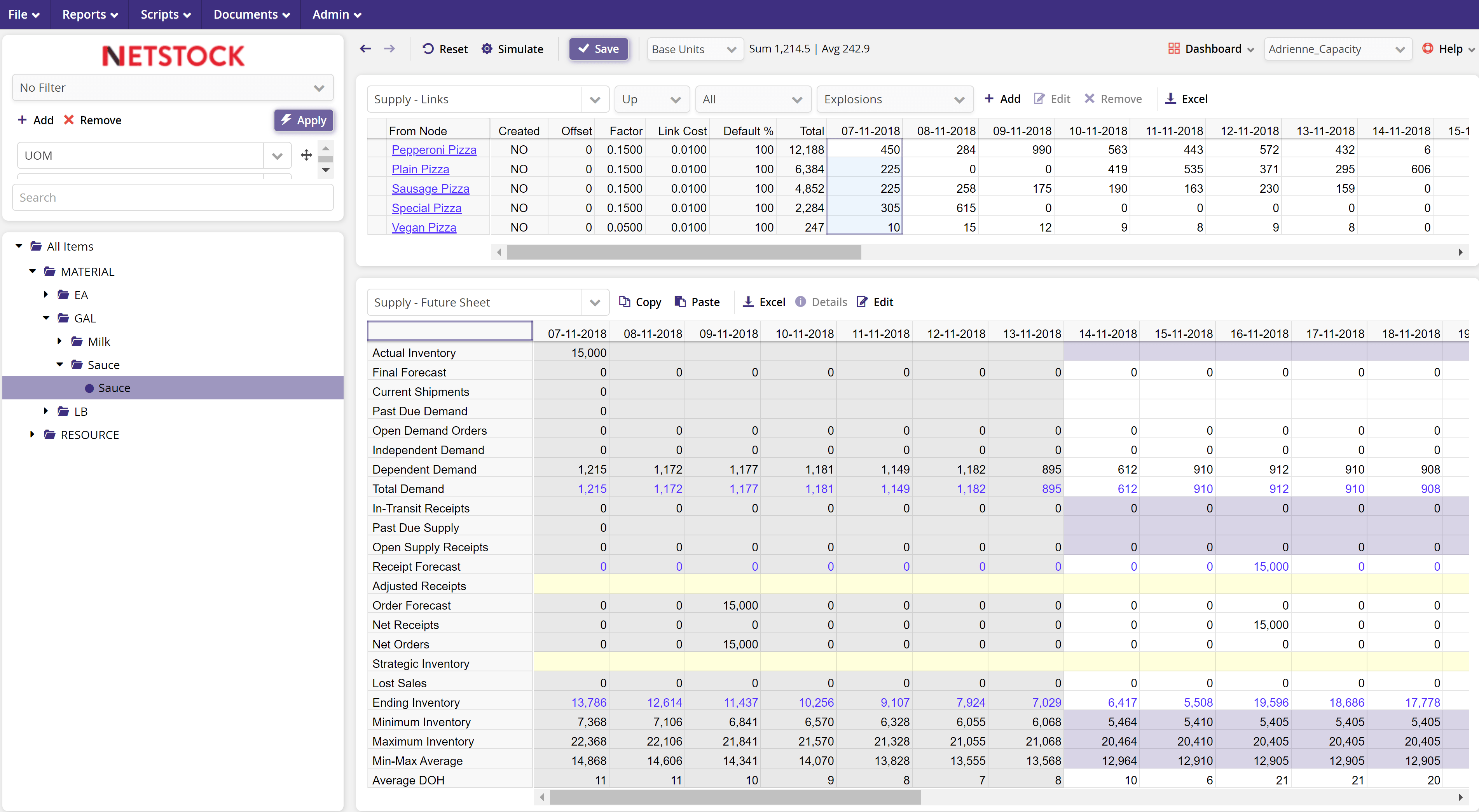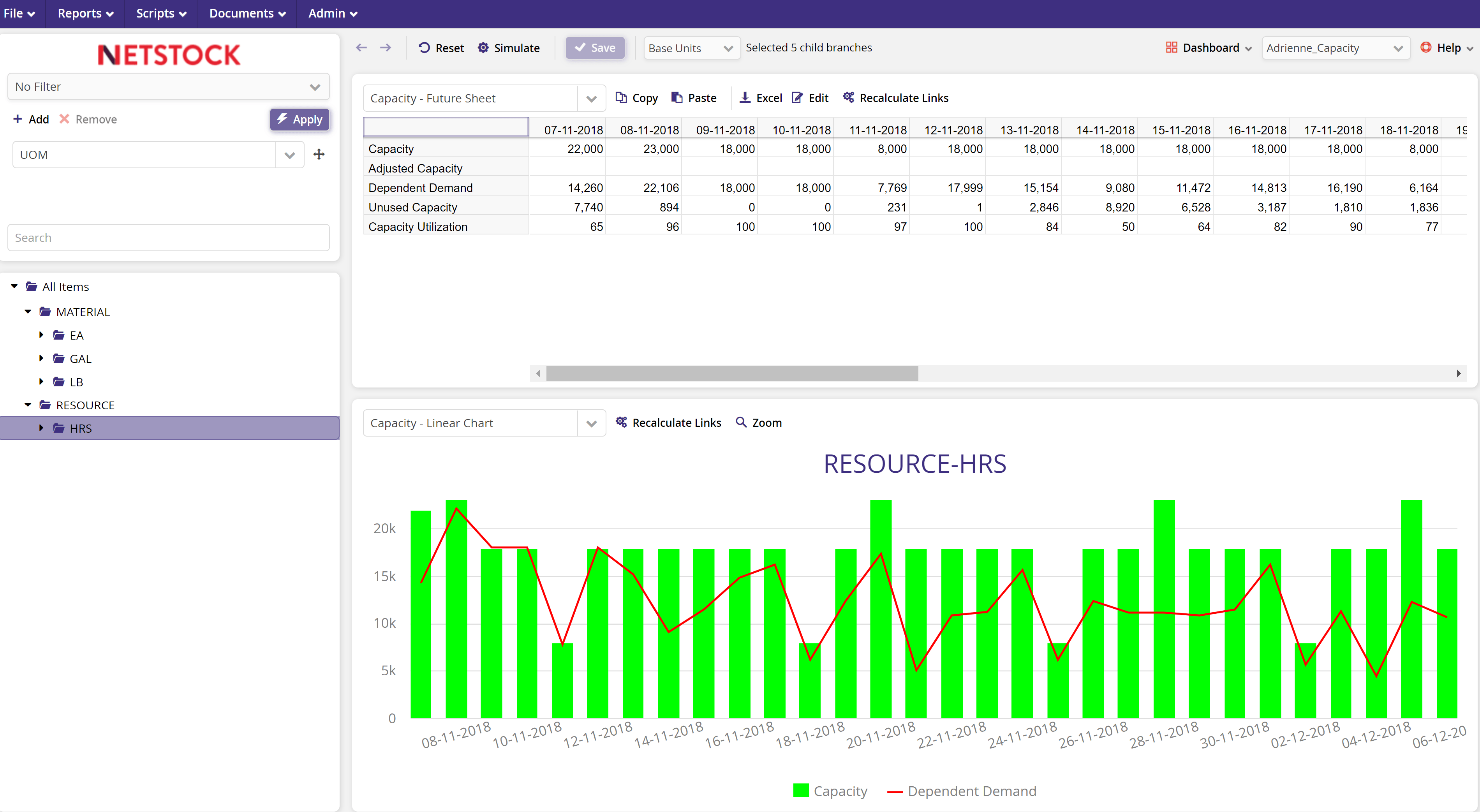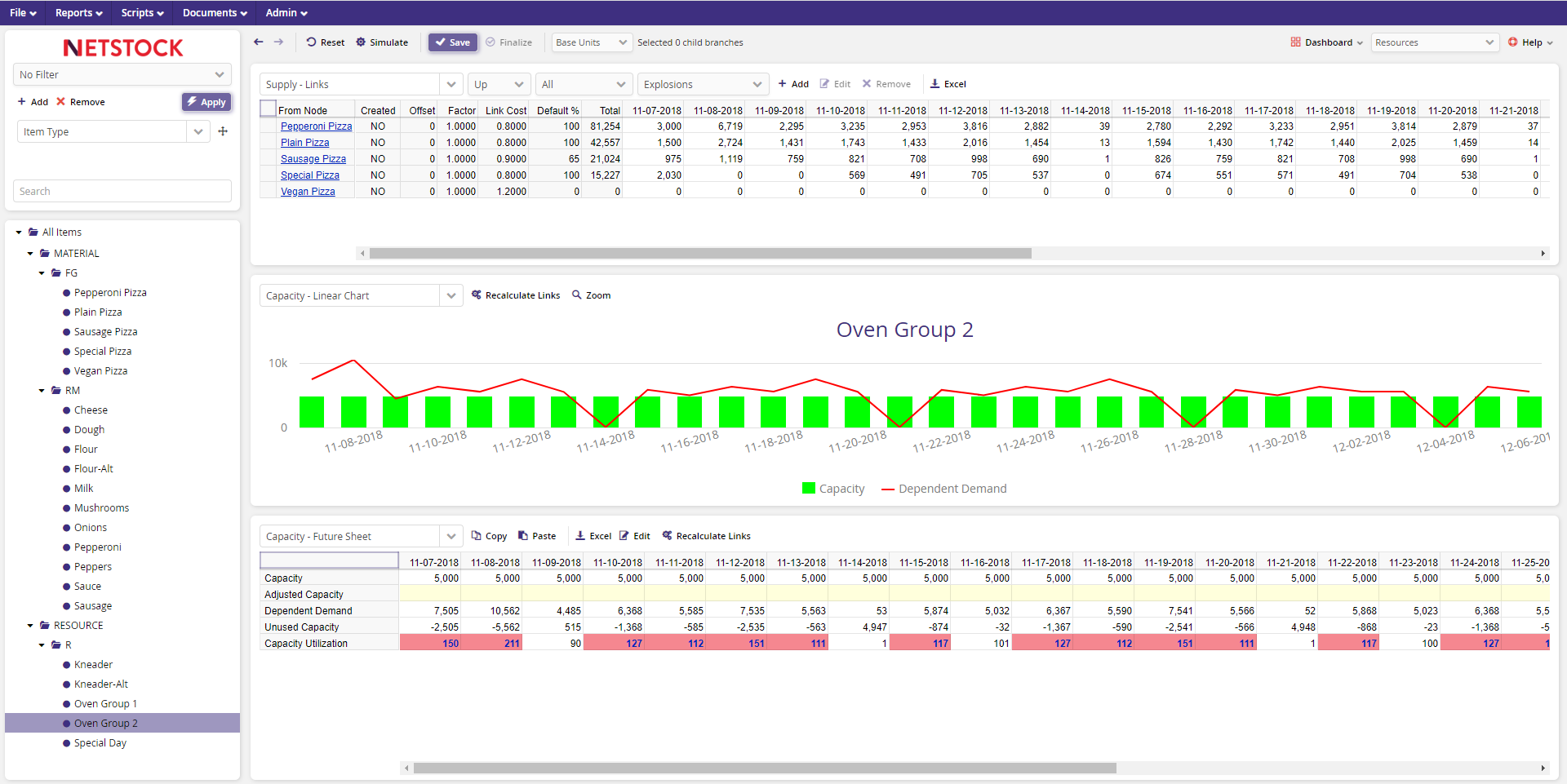Uncover the power of manufacturing capacity planning for your business. Optimize your operations for success in a competitive manufacturing industry.
In this article, we’ll explore:
- Introduction
- What is manufacturing capacity planning?
- The benefits of manufacturing capacity planning
- Key variables in manufacturing capacity planning
- What are the limitations of only relying on ERP solutions?
- Implementing manufacturing capacity planning
- How Netstock manages manufacturing capacity planning
1 Introduction
Are you tired of constantly juggling production schedules, struggling to meet customer demands, and navigating the challenges of sourcing raw materials and managing inventory levels? As a manufacturer, you know these pain points all too well. Customer satisfaction and streamlined operations are essential for manufacturers. It’s time to reevaluate your inventory planning and solutions to help you optimize your inventory, plan production, and source raw materials.
2 What is manufacturing capacity planning?
Manufacturing capacity planning is the strategic process of aligning your production and manufacturing processes to overcome the volatility of supply and demand. It means carefully evaluating resources, including machinery and workforce, to ensure your business operates efficiently, enhancing inventory visibility, improving forecasting accuracy, and using inventory management technology. The capacity planning process considers people, processes, and technology to understand and calculate the required capacity to meet the forecasted demand.
The process involves:
- Improved demand forecasting efforts: By accurately predicting future demand, businesses can plan more efficiently to reduce stock-outs and longer lead times, enhance product availability, and ensure customer-centric inventory planning.
- Having the right stock at the right time: Ensure the right products are available at the right time in the right quantities to determine current capacity and identify any room for improvement.
- Reducing long lead times: Strike the ideal balance between inventory levels and order frequency by calculating the optimal order quantity based on lead time, demand variability, and safety stock levels.
“We were able to reduce our inventory value by an impressive $1 million thanks to Netstock. Once implemented and integrated with our Sage 500 ERP, we could set safety stock parameters and measure and manage our supplier lead times. We had full visibility of our potential stock-outs and could take actionable steps to avoid stock-outs from occurring.” – Hartland Controls.
3 The benefits of manufacturing capacity planning
Manufacturing capacity planning isn’t just a process; it’s a strategic foundation that can transform your manufacturing business. By optimizing resource allocation, reducing operational costs, and enhancing customer satisfaction, you’ll not only improve the efficiency of your production line but also boost your bottom line.
“If we want 120 days of forecast on our shelf, Netstock lets us do that easily. If we have limitations in capacity, the planners can see that right away and adjust the safety stocks downward, reducing the order across all sizes. It helps us to balance sales, financial, operational, and service requirements.” – Edward Garments
Manufacturing capacity planning offers various outcomes for manufacturers.
- Optimal resource allocation: Ensure your machinery, workforce, and raw materials are used to their maximum potential so you can reduce excess inventory, minimize stock-outs, and place quicker orders.
- Reduced frequent ordering: By ordering significant days of coverage, you reduce the number of orders you need to place annually.
- Improved fill rate: By targeting a high fill rate, you always have the products in demand.
- Classified inventory: By classifying items and setting the appropriate inventory policy, you can balance your investment in inventory while achieving the desired fill rate target.
- Improved customer satisfaction: Capacity planning allows you to fulfill orders promptly, build trust, and foster long-term customer and supplier relationships.
- Enhanced long-term planning: By forecasting your capacity requirements, you can improve long-term planning. This includes investment decisions, staffing, and business expansion strategies.
- Prevent production delays: Take proactive measures to prevent disruptions, ensuring a smoother and more predictable operation.
- Cost efficiency: Capacity planning reduces operational costs. It eliminates the need for excess inventory and warehouse storage facilities, minimizes stock-outs, and keeps your financial resources focused on what truly matters.
4 Key variables in manufacturing capacity planning
The success of your business depends on how well your manufacturing is structured and a set of variables that drive operational efficiency. These variables are essential for capacity planning, ensuring the production process is finely tuned and responsive to market fluctuations.
Understand the capacity of machinery
Understanding your machinery capabilities is crucial not only for efficient production but for your overall business goals and objectives. This variable encompasses various aspects, including:
- machinery specifications
- maintenance schedules
- constraints
Knowing the capacity and limitations of each machine in your production line is essential. Regular maintenance schedules should be in place to ensure your equipment operates at its peak performance, minimizing downtime due to unexpected breakdowns. Constraints include machine changeovers, setup times, and calibration processes, affecting production efficiency and capacity. A thorough analysis of these machine-specific details lets you make informed inventory decisions on further resource allocation and production scheduling.
Links in supply chain planning relevant to capacity manufacturing planning
Evaluate your resource capacity and utilization
Utilization is a metric used in capacity planning to measure the actual capacity instead of the estimated capacity. Carefully consider the over- or under-utilization of each resource. Assessing the skills, availability, and potential skill gaps within your workforce is essential for effective labor allocation and scheduling. Start by identifying the skills and expertise of your employees. Are there specialized skills that are essential for specific production processes? Understanding your employees’ skills and competencies will enable you to assign the right people to the right tasks, ensuring efficient and high-quality production. You must also ensure the right number of employees available for your production requirements. Consider shift schedules, potential holidays or events, and possible overtime requirements. Be proactive in identifying potential skill gaps and investing in training and development programs to bridge the gaps, ensuring productive, flexible, and adaptable employees.
Utilization in Netstock
Raw material availability
If you run out of raw materials, this will affect the ability to manufacture many of your finished goods, significantly impact your sales, and disrupt your manufacturing plans. You never want to run out of key raw materials, but at the same time, you do not want to overstock these products either. Material availability is a critical variable within the scope of manufacturing capacity planning. It encompasses various dimensions, each of which plays a pivotal role in the success of your business operations. The right materials rely heavily on solid supplier relationships, efficient lead time management, and improved inventory levels.
Manage lead times
Lead time comprises the time required from order placement to order delivery. It encompasses various stages, including order processing, production, quality control, and shipping. By carefully managing and optimizing each stage, you can meet customer expectations, reduce the risk of backlogs, and ensure you meet your target fill rate. Reducing lead times not only enhances customer satisfaction but also opens up opportunities for last-minute adjustments and cost savings. This involves streamlining processes, improving production efficiency, and maintaining clear communication with customers and suppliers to minimize lead times at every step of the production cycle.
Accurate processes for operational efficiency
Creating an accurate capacity plan for each process and resource is vital. Each product must incorporate the labor, unit of measure, and workload required to produce items according to the Bill of Materials (BOM).
Visualize and optimize your manufacturing and distribution with Netstock
“We are keeping our key customers happy by delivering their orders on time, and we managed to reduce our back-orders from 277 to 20. We were also able to show our new customers our OTIF statistics, which made them comfortable to commence business with us. This was the best ROI we could have hoped for.” – Aero Health
5 Implementing manufacturing capacity planning
Implementing manufacturing capacity planning can seem complicated, but it doesn’t have to be. Here are some steps you can take to get started:
- Define your goals. Before implementing any new process, it’s essential to define your goals. What do you hope to achieve with manufacturing capacity planning? Do you want to reduce inventory costs, improve customer satisfaction, or something else?
- Identify key variables. Identify the key variables that impact your business, such as lead times, order frequency, and demand variability. By understanding these variables, you can more accurately forecast demand and optimize production processes.
- Train your team. Manufacturing capacity planning requires input from all business departments, from sales and marketing to production and operations. Train your team on the new process and ensure everyone understands their role in the planning process.
- Monitor and adjust. Monitor your progress and adjust your planning as needed. Regularly review your forecasts and adjust your inventory levels and production processes to meet your goals.
- Embrace inventory management software. In a recent Netstock survey, 92% of respondents stated that over the last three years, supply chain disruptions have caused a significant increase in inventory that needs to be kept on hand. Further, only 22% of the respondents use commercial inventory management software.
6 What are the limitations of only relying on ERP solutions?
While ERP systems are invaluable for many aspects of manufacturing, they have their limitations:
- Granularity and scalability: ERP systems provide excellent high-level overviews of your inventory but often need more details to create a capacity plan.
- Supply chain disruptions: Manufacturing is a dynamic industry with rapidly changing conditions. ERP systems may struggle to keep pace with real-time changes and supply chain disruptions.
- Resource allocation and optimization: ERP systems are designed for broader management and may not offer the insights and tools required for optimizing manufacturing resource allocation.
- Better inventory decisions: Effective capacity planning relies on data-driven inventory decisions, and ERP systems do not often provide the advanced analytics and forecasting capabilities necessary for comprehensive inventory planning.
7 How Netstock manages manufacturing capacity planning
Netstock’s manufacturing capacity planning functionality helps balance inventory and production plans while considering resource capacity constraints, making capacity planning more efficient and effective.
- Planned/unplanned maintenance: You can adjust capacity as needed to accommodate planned or unplanned maintenance or holiday season time off, ensuring a smooth production process.
- Adjusted Capacity Planning: When faced with excessive demand compared to current capacity, you can use Adjusted Capacity to reflect overtime or extra shifts, addressing overutilization concerns.
- Capacity utilization: The Capacity Utilization feature highlights periods with overutilization and enables proactive adjustments to ensure optimal resource allocation.
- Linking material production requirements to alternative resources: You can link material production requirements to multiple alternative resources, making it easier to adapt to varying productivity rates and limited resource availability.
- Finite capacity planning: Netstock’s Finite Capacity Planning Optimization engine is a powerful tool for determining the best resource allocation and production plan, considering available capacity and demand requirements.
Manufacturers can turn to Netstock to make better inventory decisions about resource allocation and demand forecasting.








